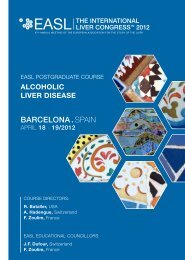EASL clinical practice guidelines for HFE Hemochromatosis
EASL clinical practice guidelines for HFE Hemochromatosis
EASL clinical practice guidelines for HFE Hemochromatosis
Create successful ePaper yourself
Turn your PDF publications into a flip-book with our unique Google optimized e-Paper software.
Article in Press 9Clinical Practice GuidelinesTable 6. Data from studies addressing the penetrance of C282Y homozygotes.Authors Ref. Study type C282Yhomozygotes(females)Definition of penetrant disease AffectedindividualsPenetrance CommentsBurt et al. (1998) [10] Cross-sectional 5 (4) Hepatic iron index >1.9 upon liverbiopsyDistante et al. (1999) [13] Cross-sectional 2 (1) Iron removed >5 g or HII >1.9 orhistological iron grade >2+McDonnell et al. (1999) [127] Cross-sectional 4 (3) Iron removed >5 g or HII >1.9 orhistological iron grade >2+3 60% No liver biopsy in unaffected individuals because ofnormal serum iron parameters1 50% Unaffected patient had Pearl’s stain Grade 2 and HII of 1.73 75% One unaffected patient had elevated serum ironparametersOlynyk et al. (1999) [14] Cross-sectional 16 (9) HII >1.9 or histological iron grade >2 9 56.3% Two additional patients had serum ferritin of 1200 mg/Land 805 mg/L respectively, but did not undergo liverbiopsy. Cirrhosis was found in 1 patient, fibrosis in3 patients, and arthritis in 6 patientsDistante et al. (2000) [136] Cross-sectional& short termfollow upBulaj et al. (2000) [137] Cross-sectional –affectedindividualsCross-sectional –family membersCross-sectional –unselectedBarton et al. (1999) [138] Cross-sectional –family based14 (9) HII >1.9 or histological iron grade >2or congestive heart failure + markedand persistent hyperferritinemia andTS > 55%184 (48) At least one disease-relatedcondition (cirrhosis, fibrosis, elevatedALT or AST, arthropathy)3 21.4% Liver biopsy available only in 5 patients; a total of5 patients of whom 4 had no biopsy had persistenthyperferritinemia137 74.5%214 (101) 33 15.4%107 (41) 7 6.5%25 (n.d.) Cirrhosis or diabetes attributable toiron overload6–23 24–79% Ill-defined HC phenotype was present in a total of 23patientsBeutler et al. (2002) [21] Cross-sectional 152 (79) ‘liver problems’ (assessed in 124) 10 8.1% Signs and symptoms that would suggest a diagnosis of HCin only one patientWaalen et al. (2002) [139] Cross-sectional 141 (80) Only symptoms and serum ironparameters reportedDeugnier et al. (2002) [23] Cross-sectional 54 (44) At least one disease-relatedsymptom (fatigue, arthralgia,diabetes, increased ALT)Phatak et al. (2002) [26] Cross-sectional 12 (8) Iron removed >5 g <strong>for</strong> males and >3g<strong>for</strong> females92 patients had elevated serum ferritin concentrations,disease-associated symptoms were equal in control groupand C282Y homozygotes35 64.8% 21 patients had increased serum iron parameters5 42% Increased serum ferritin in 50% of patientsPoullis et al. (2003) [98] Cross-sectional 12 (5) Histological iron grade >2 7 58% Increased serum ferritin in 11 out of 12 patients, butcoincidence of significant co-morbidities (HCV and iron in5 patients)Olynyk et al. (2004) [140] Longitudinal 10 (6) Hepatic iron >25 mmol/g 6 60% Gradual increase in TS over 10 year observation – nobiopsy in 4 patientscontinued on next pageClinical PracticeGuidelinesJournal of Hepatology 2010 | xxx–xxxxxPlease cite this article in press as:European Association <strong>for</strong> the Study of the Liver. <strong>EASL</strong> Clinical Practice Guidelines <strong>for</strong> <strong>HFE</strong> <strong>Hemochromatosis</strong>.J Hepatol (2010). doi: 10.1016/j.jhep.2010.03.001. © 2010 European Association <strong>for</strong> the Study of the Liver.












